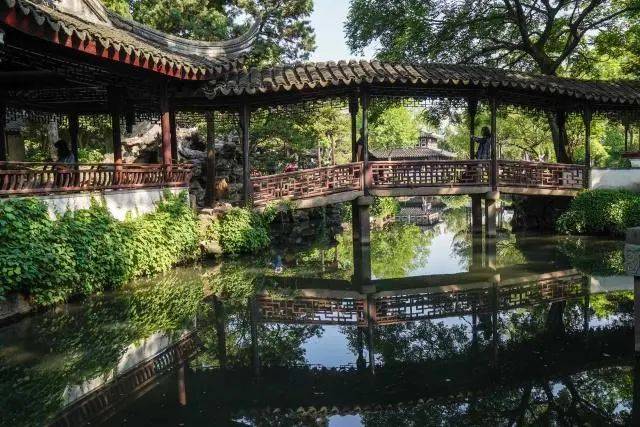音频中的美音原版音频片段 , 来自“ 中国读本 ”系列丛书
这套书由人民教育出版社与美国国家地理学习联合出版
旨在弘扬与传播中华优秀文化的英语读本
苏州园林 , 溯源于春秋 , 发展于晋唐 , 繁荣于两宋 , 全盛于明清 。 今天我们就来了解一下苏州园林的历史:

文章图片
新华社采访人员 李博 摄
The history of Suzhou's gardens can be traced as far back as the Spring and Autumn Period. Distinctivegardens continued to appear throughout the subsequentdynasties, but it was during the Ming and Qing that the garden art of Suzhou was at its zenith. The prospering city and its outskirts were dotted with exquisiteprivate gardens.
苏州园林的历史可以追溯到春秋时期 。 在随后的各个朝代 , 独具特色的园林不断出现 。 在明朝和清朝期间 , 苏州的园林艺术达到了顶峰 。 繁华的都市及其周边点缀着精致的私家花园 。
distinctive[d??st??kt?v]
adj. 独特的 , 与众不同的
subsequent[?s?bs?kw?nt]
adj. 随后的 , 接着的
例:
The increase of population in subsequent years.
【皇家|【中国读本里的魅力中国】苏州园林(4)——苏州园林的历史】随后几年中的人口增长 。
Developments on this issue will be dealt with in a subsequent report.
这个问题的发展将在以后的报道中予以说明 。
zenith[?zen?θ]
n. 顶峰;顶点;最高点
exquisite[?k?skw?z?t]
adj. 精致的 , 精美的
Imperial gardens and private gardens each developed their own distinctive features over many years. The imperial gardens of Beijing are considered the finest examples of that style. They are noted for their expansive size, grandeurand stateliness. The gardens of Suzhou are the epitome of landscaping art for the private garden, with their delicacy, intimacy, and simplicity. The designers of private gardens, not bound by the rigid conventionsof the imperial court, had greater freedom of expression in their art.
多年来 , 皇家花园和私人花园都发展出了自己独特的特色 。 北京的皇家园林被认为是最好的 , 它们以其规模宏伟和庄严而著称 。 苏州的园林是私家园林的缩影 , 以其精致、私密和简洁而出名 。 私家园林的设计者不受皇家宫廷园林设计的束缚 , 在艺术上有更大的表达自由 。
grandeur[?ɡr?nd??(r)]
n. 壮丽 , 雄伟
stateliness[?ste?tlin?s]
n. 威严;庄严
intimacy[??nt?m?si]
n. 亲切宜人 , 幽静
convention[k?n?ven?n]
n. 习俗;(文学、艺术上的)传统手法 , 传统风格
例:
By convention the deputy leader was always a woman.
按惯例 , 这一领导职务的副职总是由女性担任 。
It's just a social convention that men don't wear skirts.
男人不穿裙子仅仅是一个社会习俗 。
The ancient gardens of Suzhou were designed to be lived in as much as were the houses to which they were attached. Paths invited residents and their guests to wander, offering a new view at every bend; pavilions, gazebos or simple seats offered comfortable spots in which to relax, chat, and perhaps to take some refreshments or pen a poem. This type of landscaping was often used in the densely populated cities, where residents recalled the countryside with nostalgiaand yearned to commune with nature.
苏州古代园林的设计目的是为了让人们居住 , 就像它们合为一体的的房屋一样 。 园中的小路供主人和他们邀请的客人漫步 , 小路的每一个转弯处都给人不同的视觉感受 。 凉亭或简单的座椅让人们走累了休息一会 , 在那里放松、聊天 , 也许还可以吃点点心或写首诗 。 这种类型的园林设计通常用于人口较密集的城市 , 让那里的居民用怀旧的心情回忆起之前的乡村 , 与大自然交流 。
- 乌首期|俄对乌首期主要任务总体完成
- 中国|我市30余种图书期刊入选
- 便民,服务|清明祭扫 多项服务更便民
- 张祥龙|张祥龙|自从有了现象学,中国哲学的面貌焕然一新了
- |【铜吴堡美文】韩万胜:母亲的油茶鸡蛋
- 日本队|日本名帅:中超只是一个伪职业联赛,所以他们很难培养出优秀的球员
- 诗社|【友社互联】黄龙诗社·吕秀娟诗词选
- 大连|1960年的大连老照片
- 清风|【清风诗苑】刘博/瞩望(外二首)
- |【洞庭作家】彭盼兮/山城春雨
